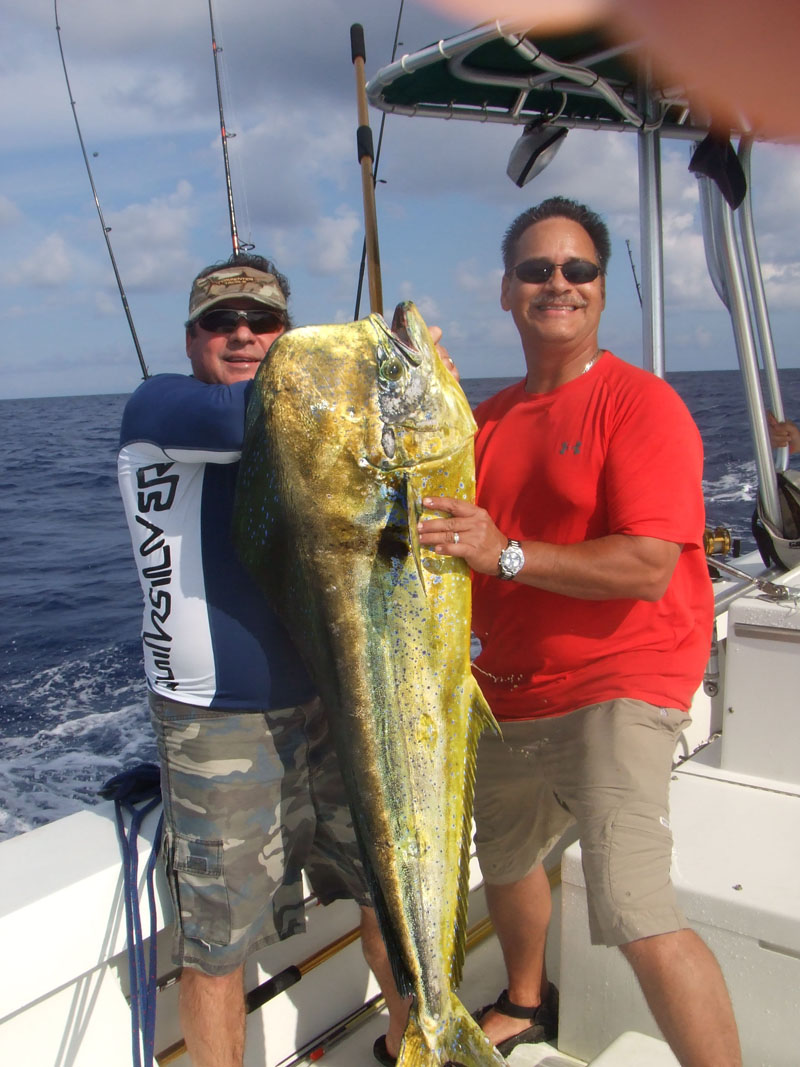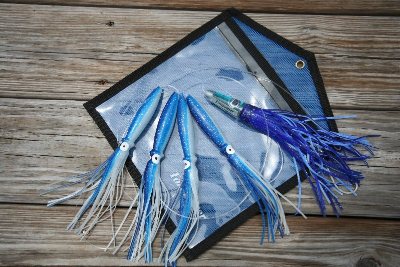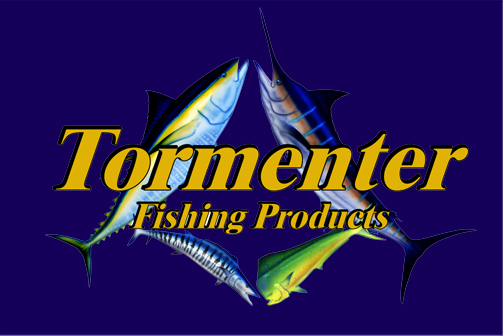Fishing for Dolphin


This 45lb Dolphin Caught on this exact Tormenter Cone Head/Squid Chain
Hmmmm, everyone knows how to fish for Dolphin, right? Why do I bother even writing this page? Well, there are a lot of good fishermen that catch Dolphin, and even mediocre fishermen that catch Dolphin, but I would bet that even some of the hottest tournament winners might learn something from this page. Even if they have done most or all of what is listed below, I might just remind them of something they haven't tried in a while.
Depth of water:
I have caught Dolphin in 45 feet of water, but that is a fluke. They will however venture into 80' - 100' on a regular basis. There have been times that here in Palm Beach you need only run a mile or so to start trolling (productively). I actually hooked a nice gaffer dragging my baits past the sea bouy at Lake Worth Inlet, and every spring, it seems that the Dolphin will congregate along the edge between 90 and 350 feet and provide lots of action. Other days, you may need to run 30 miles to find the right weed line or current edge. Of course, this is a short hop compared to the canyon runs neccessary in the Northeast.
Signs:
First, everyone knows that when fishing for Dolphin, look for stuff floating, right? There are lots of things you might find on or just below the surface of the water that might hold bait, in turn holding Dolphin. I have caught Dolphin on: Small pieces of wood, large pieces of wood, plastic buckets, Palm trees, stair cases, Cuban rafts, floating coils of line, Bird on a board, weed patches, weed lines, scattered weeds, lobster buoys, plywood, and more. So, keep you eyes peeled and find something that will hold the fish.
Birds - Of course, but which birds? How can you tell they are on Dolphin? It would be impossible for me to explain this to you without having you out on the boat for a month, but keep in mind that many times I have chased down birds where the Dolphin are swimming at least 12 knots, got in front of the fish, fired the lures out, slowed to a troll and hooked up. I found birds last month on Dolphin that were moving at 20 knots. When I finally got in front of them I fired out the lures, and hooked up. It was a decent Dolphin, but by the time we gaffed him the birds were out of sight and the Dolphin were gone. I prefer my Dolphin a bit lazier, maybe milling around a board, with birds fluttering about to let me know they are there.
Frigate or Man-O-War Birds - These guys are serious and will seldom let you down. The higher they are, the deeper the Dolphin are and vice versa. When I see a Man-O-War flying and darting around just above the water, chasing flying fish as the Dolphin chase them out of the water, I get wood. If you see this, get pitch baits ready to deploy but you may not want to stop trolling until you have passed your baits beneath the bird/s at least once.
I had a super day a few years back finding a pair of Frigates that were hanging around 40 - 60 feet up, and every time we dragged our lures beneath them we hooked up. The fish were sizable and we needed time to boat them. Each time after boating our Dolphin we had to really look hard to find the birds again. But each time we did find them, and we would catch more fish. We ended up with two around 50lbs each, and another seven that averaged 25lbs. We were tied back to the dock at 11:00 AM and spent the rest of the day filleting and bagging fresh meat.
What to do when you hook a Dolphin:
1. Keep trolling after you have hooked the Dolphin for at least 5 - 6 seconds to see if you will get another bite
2. Look for other Dolphin that may be with him
3. Have a pitch bait or jig ready to throw at any other fish
4. After boating the (single) fish, loop around and troll back over the same area. Repeat this if you think there are more fish there, especially if fishing has been slow.
What to do if you catch one trolling and another fish or two follow him to the boat:
1. Pitch baits in front of the Dolphin that follow. Chances are that they will eat. Throw some chum, look for more Dolphin. If you find a School, follow the steps below:
What to do when you find a school of Dolphin:
1. If the Dolphin are out in the open with no debris to hold them:
a. Put boat into a fairly tight circle at around 2 knots while throwing chum. Moving the boat ahead creates a current that you will use.
b. Throw chum. This can be glass minnows, Small chunks of Ballyhoo, or small chunks of any other baitfish. Dolphin love "free food"
and should stay with you if you keep the chum flowing steadily
c. Lay hooks into the water with chunk baits and let them drift back in the current created by the boat moving ahead
d. Keep one hooked Dolphin in the water and this will keep the school (usually) from disappearing. Important... Change
the fish being used as your decoy often as if not they will loose color and the school will vanish!
d. Gaff fish on the side of the boat (not the stern) while the boat continues to move forward.
2. If the Dolphin are being held on a board or other floating debris:
a. Mark your Spot! I can't tell you how many times I have asked one person on the bridge to keep the board (or debris) in their sites while I pay attention to the fish and then when I ask where the board is, they have no idea. Use a Buoyed flag, like a dive flag. The red color is easy to see from a distance. If you attach a gallon jug of water to the bottom of the flag with a 3' piece of line, it will be apt to stay with the debris better as it will be effected by the current rather than just by the wind.
b. You can troll past the debris several times if you prefer, but can then stop on the debris (easy to find with the flag you deployed earlier) and then chum and throw chum and chunk baits or jigs.
3. If they won't Bite:
a. Step down your hook size, if that doesn't work;
b. Step down your leader size
c. Do both a & b. I recently stepped down all the way to a #1 hook with 12lb test mono straight to the hook. This Produced very well for Dolphin that wouldn't eat anything else we threw (besides the chum)
c. Cast and Jig your chunk baits to excite the fish
If you think they should be there but you don't see them:
a. Stop on the debris and drop a Tormenter "Ballyhoo" or "Chubby Jr" down to around 80 feet. Reel & jig back to the boat. I had three Dolphin follow the jig back to the boat once and then we pitched chunk baits to them with small hooks and light leaders (as they were very finicky)
b. Drop chunk baits (or live baits) down to around 60' while throwing bits of chum occassionaly. Leave a bait or two behind the boat on the surface as well.
Typical "School Dolphin" pitch bait rig: 12 - 30lb spin with five foot leader usually 40 - 60lb test and a 6/0 hook. Bronze colored live bait hook if the fish are now my standard as the fish tend to be a bit finicky or go a long shank hook if the fish are hungry. The long shank hook will make it easier to take out of the Dolphin for quick re-deployment. You can use bait caster rod/reels, or even 3/0 - 4/0 (20's & 30's) conventionals. I have actually used 6/0 and 9/0's (50's & 80's) when in a school of large Dolphin.
Typical Dolphin Chunk Bait: Cut Ballyhoo: The one's I usually have ready (that can be pulled through the water without spinning) will be a tail plug which is a piece around 2" - 3" long with the tail cut off. Place the hook through the narrow end (once only) with the tip and the barb completely exposed. The other preferred chunk bait is the head but with around 2" of meat behind the head. Break off the bill and hook through the bottom of the chin and up through the forehead, again with the tip and barb completely exposed.
Other "Chunk baits" include: Whole Squid, Chunks of Bonita, Dolphin belly strips, King Mackerel Bellies, Mullet Chunks, Finger Mullet, Whole Greenies or Pilchards, Cut or Whole Bunker, Chunks of Tinker Mackerel, or anything you can get your hands on that you think a Dolphin will eat.
Trolling Baits for Dolphin:
Ballyhoo
Mullet
Strip Baits
All of Tormenter's lures on our Dolphin Lures Page
Lure Colors for Dolphin:
Many people will tell you to use bright colors on Sunny days and darker colors on overcast days. While this may hold some truth, I will usually start the day with four or five different colors and then double up on the color that gets its second hit first increasing my chance for a double header.
In 1980 I was the mate on the winning boat at the Atlantic City Marlin Tournament giving my anglers seven shots at White Marlin each of the two days. The first day, I settled in using two whole squid (pinkinsh in color) and two Bonita strips on the flat lines with 1/4oz pink Sea Witches. We saw lots of Tuna and Dolphin as well as the Whites that day.
The second day, neither Pink or Squid raised anything and I settled in with Swimming mullet on the flat lines and Ballyhoo with Purple Sea Witches on the rigger baits. Most other boats at the time were dragging "Green Machines" as the other mates could not rig baits and the Green Machine was one of the only lures at the time considered to be good for catching Marlin (in New Jersey). It is no wonder that we kicked butt as we were using the proper colors rather than just green. Fishing out of Ocean City, MD the same year, we didn't fare as well as these competing boats had much more experienced crew all doing what I was, but they found the congregated fish while we did not.
In any case, one recent Dolphin trip ended up with four Dolphin and a Barracuda eating our Blue & White Squid/Cone Head Daisy Chain, one Dolphin on a Blue & White Steel Head, One Dolphin on a 9" Green Tuna Bandit, and one Dolphin on a Rainbow Squid/Tuna Bandit Daisy Chain. This will certainly show that the fish preferred Blue & White that day. Another trip, I had seven out of eight fish caught eat the same Mackerel colored Bird/Bone Head Chain while the only other trolling fish caught was on a Rainbow 9" Spreader Bar rig. These patterns have proven themselves time and time again for me and if you start fishing with this in mind, I am sure you will be able to discover (and take advantages) of the daily patterns.
My suggestion is to always have enough of one color lure to have it out on every line with spares.
Lure Models for Dolphin in different conditions:
The model of the lures are also important as on real windy days you may wish to have all heavier baits in the riggers like our "Cone Head" and maybe "Steel Heads" or Daisy Chains on the flat lines, while on a calmer day you may prefer "Bone Heads" in the riggers, a "Steel Head" WFB, and squid Chains on the flats.
Some days you don't dare put anything out that will ride below the surface because of all the scattered weed that the Dolphin may be laying under. They will NOT eat a lure no matter how good it is when it is covered with weed. For this reason, models like Our "Bone Head" are good as they will usually pop over the weed and not get fouled near as often as our "Cone Head".
More to come.......
In any case, I don't leave the dock without a full array of colors and styles.
Click on this link to be directed to our
Dolphin Lure Page
where you will find lures that have proven to be exceptionally productive in catching Dolphin.








































